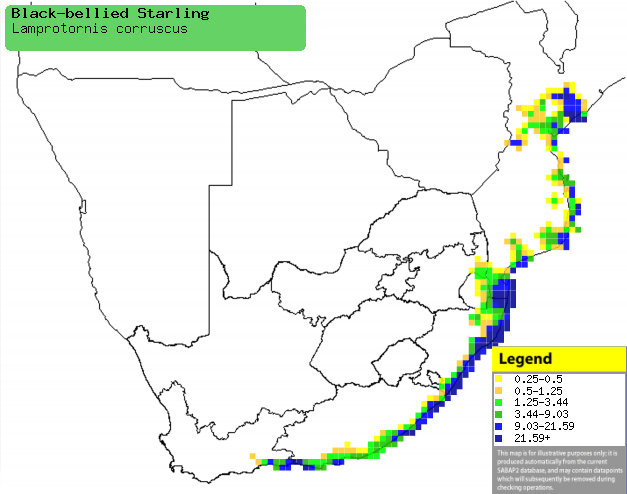|
Lamprotornis corruscus
(Black-bellied starling)
Swartpensglansspreeu [Afrikaans]; Intenenengu,
Isithenenengu [Xhosa]; iKhwezi, iKhwinsi (generic terms for glossy starlings)
[Zulu]; Zwartbuik-glansspreeuw [Dutch]; Choucador à ventre noir [French];
Schwarzbauch-glanzstar [German]; Estorninho-de-barriga-preta [Portuguese]
Life
> Eukaryotes >
Opisthokonta
> Metazoa (animals) >
Bilateria >
Deuterostomia > Chordata >
Craniata > Vertebrata (vertebrates) > Gnathostomata (jawed
vertebrates) > Teleostomi (teleost fish) > Osteichthyes (bony fish) > Class:
Sarcopterygii (lobe-finned
fish) > Stegocephalia (terrestrial
vertebrates) > Tetrapoda
(four-legged vertebrates) > Reptiliomorpha > Amniota >
Reptilia (reptiles) >
Romeriida > Diapsida > Archosauromorpha > Archosauria >
Dinosauria
(dinosaurs) > Saurischia > Theropoda (bipedal predatory dinosaurs) >
Coelurosauria > Maniraptora > Aves
(birds) >
Order: Passeriformes
> Family: Sturnidae
> Genus: Lamprotornis
Distribution and habitat
Occurs along coastal lowlands from southern Somalia down
the eastern edge of Kenya and Tanzania to southern Africa. Here it is locally
common from central and south-eastern Mozambique to South Africa's eastern and
southern coastline, generally preferring coastal plains, forest and bush with
dense vegetation and heavy rainfall.
|
 |
|
Distribution of Black-bellied starling in southern Africa,
based on statistical smoothing of the records from first SA Bird Atlas
Project (©
Animal Demography unit, University of
Cape Town; smoothing by Birgit Erni and Francesca Little). Colours range
from dark blue (most common) through to yellow (least common).
See here for the latest distribution
from the SABAP2. |
Movements and migrations
Mainly resident, although in Summer in
Mozambique it moves further inland up to the Zimbabwean border.
Food
It mainly eats fruit, supplemented with insects and small
vertebrates, doing its foraging on the ground and in the trees but occasionally
hawking prey from a perch. The following food items have been recorded
in its diet:
- Plants
- fruit
- Rotheca myricoides (Cats-whiskers)
- Melia azedarach (Persian lilac)
- Olea capensis (Ironwood)
- Osyris lanceolata (Rock tannin-bush)
- Acacia cyclops (Rooikrans)
- Rapanea melanophloeos (Cape beech)
- Morus alba (Mulberry)
- Harpephyllum caffrum (Wild plum)
- Phoenix reclinata (Wild date palm)
- Akonthera oppositifolia (Common poison-bush)
- Ficus (figs)
- Trichilia emetica (Natal mahogany)
- Dovyalis longispina (Coastal kei-apple)
- Euclea natalensis (Hairy guarri)
- Trema orientalis (Pigeonwood)
- Halleria lucida (Tree-fuchsia)
- Ekebergia capensis (Cape-ash)
- Apodytes dimidiata (White-pear)
- Mimusops caffra (Coastal red-milkwood)
- Sideroxylon inerme (White-milkwood)
- Bridelia micrantha (Mitzeerie)
- nectar of Aloe marlothii (Mountain aloe)
- Animals
-
termites
- ants
- snails
- lizards
- reed frogs (Hyperolius)
Breeding
- It nests in tree cavities, either natural or abandoned
woodpecker or
barbet holes, lining the interior with
grass, dry leaves, hair and feathers. It often has to compete with other
birds for nest sites, in fact they are sometimes displaced by
Common starlings and
Green wood-hoopoes.
- Egg-laying season is from October-January.
- It lays 2-4 eggs, which are incubated solely by the female.
- Little is known about the chicks, other than that they are fed by both
parents.
Threats
Not threatened.
References
-
Hockey PAR, Dean WRJ and Ryan PG 2005. Roberts
- Birds of southern Africa, VIIth ed. The Trustees of the John Voelcker
Bird Book Fund, Cape Town.
|
